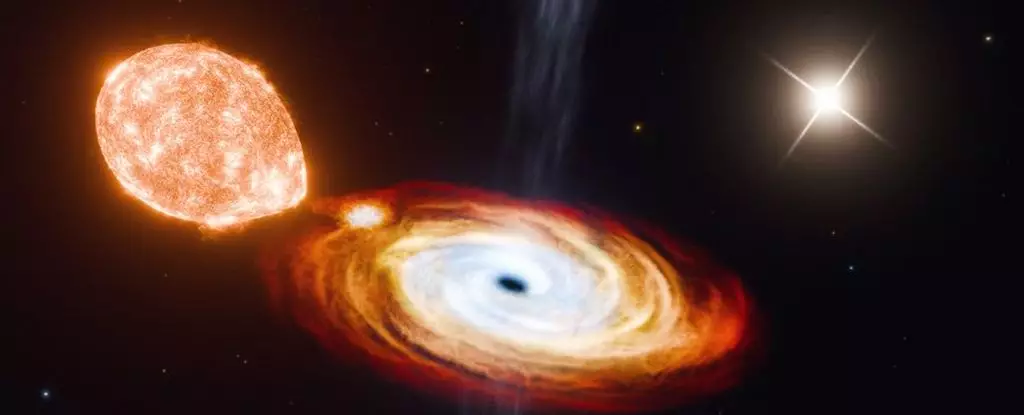In the vast reaches of the constellation Cygnus, approximately 7,800 light-years from our home planet, lies a fascinating astronomical puzzle: the V404 Cygni system. This intriguing binary system has captivated scientists and stargazers alike due to its unusual characteristics, including a newly revealed third companion that promises to reshape our understanding of black hole formation and dynamics. The presence of this companion raises significant questions about the mechanisms behind black hole creation, challenging conventional theories that posit supernovae as the primary formation process.
Recent observations from the European Space Agency’s Gaia mission have unveiled a third celestial body orbiting V404 Cygni. While V404 Cygni was previously known to have a short-orbiting companion star—one that circles the central black hole in just 6.5 days—this newly identified star has been found to follow a remarkably wide orbit, estimated at around 70,000 years. This revelation categorizes V404 Cygni as a trinary system, a first in our observations of black holes. The implications of this discovery could be monumental, as it allows researchers to investigate the evolutionary paths of such systems, leading to deeper insights into the lifecycle of black holes.
Traditionally, the formation of stellar-mass black holes was attributed primarily to the violent explosions of supernovae. In these scenarios, a dying star’s core collapses under immense gravitational pressure while its outer layers are ejected into space. However, the newly discovered trinary aspect of V404 Cygni casts a shadow of doubt over this established model. Kevin Burdge, a physicist at the Massachusetts Institute of Technology, underscores that the peculiar features of this system could signify that black holes might arise from mechanisms previously considered negligible, especially the direct collapse model.
In the case of direct collapse, a massive star implodes directly into a black hole without the explosive remnants that characterize a supernova event. This process is especially intriguing within V404 Cygni, as it helps explain why the gravitational relationship between the black hole and the newly identified star continues to hold despite the distance. The connection presents a significant challenge to supernova theories that suggest such wide orbits should break apart under gravitational strain.
The study of V404 Cygni and its companions points towards a possible paradigm shift in our understanding of black hole formation. Through meticulous simulations, Burdge and his team argued that the evidence leans heavily toward the premise that these stellar objects were already gravitationally bound when the black hole formed. This insight not only breathes new life into the direct collapse theory but also suggests that the dynamics of triple systems may be more common than previously acknowledged.
Kareem El-Badry, an astronomer at Caltech, emphasizes the importance of these findings, noting that if trinary systems are indeed a frequent occurrence in the universe, they could provide critical insights into longstanding questions surrounding black hole binaries. The existence of a stable third body could open up evolutionary pathways that are typically unfeasible in pure binary systems, thus enriching our understanding of stellar evolution.
As scientists continue to unravel the complexities surrounding V404 Cygni, the quest for a deeper understanding of the universe’s hidden phenomena accelerates. If the insights drawn from this trinary system prove accurate, they could serve as a stepping stone for discovering other wide black hole-inclusive trinaries that remain obscured by the black holes’ elusive nature. Identifying these systems will be essential for evolving our models of how black holes emerge and evolve.
As we expand our research frameworks and enhance observational technologies, it is hopeful that we will not only procure an abundance of new data but also refine our theoretical models. The implications of hidden systems like V404 Cygni reach far beyond individual celestial mechanics; they promise to enrich our understanding of fundamental cosmic processes, ultimately offering us profound answers to the mysteries that lie within the heart of our universe.
V404 Cygni serves as a remarkable case study in black hole astrophysics, embodying the complexities and wonders of the cosmos. As we begin to see the potential of triple systems, the exploration of their evolutionary implications may lead us to fundamentally reassess the nature of black holes and their role in the narrative of star life. The journey into the depths of black holes is only beginning.

